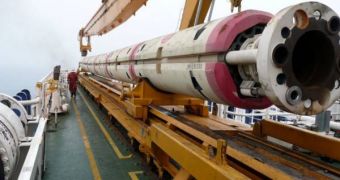Using advanced equipment aboard the Chikyu (which translates into 'Planet Earth') drilling vessel, Japanese scientists have managed to drill a hole more than one mile deep into the ocean floor in the Nankai Trough earthquake zone, one of the most active in the world today. Located about 36 miles Southeast of the coasts of Japan, the region was breached using a revolutionary technology known as riser drilling, which allowed scientists to collect rock samples and install long-term monitoring equipment.
The instruments will hopefully be able to provide seismologists with early warnings of when an earthquake is about to happen, and allow for enough time to alert the civilian population in the areas estimated to be affected. Other than the shock waves of the tremor, the people living in those areas could also avoid the effects of the ensuing tsunami waves, which are usually generated in the case of an earthquake taking place in the open seas.
In the case of the Nankai region, what makes it so active is the fact that it's situated right at the point where the Philippines tectonic plate collides with the Japanese one. Scientists hope that the newly installed equipment will give them a better clue as to how energy builds up in the collision, which is the main trigger of earthquakes. As the plates slam into each other, they can get tangled up, and not flow one under the other. When this happens, energy starts building up on account of the friction forces.
When the stored energy becomes too large to be contained, the plates push against each other so hard, that the friction forces holding them against each other are overcome, and the plates violently set into place. That released energy is what gives the strength of a tremor, therefore understanding it is of vital importance in predicting how such an event will affect the regions around it. “One of the key benefits [of riser drilling] is the pressurized mud keeps the wall rock from collapsing on the drilling pipe, which allows you to drill deeper and with better control,” University of Connecticut geologist Timothy Byrne explains in an e-mail.
“For example, nearly perfectly vertical holes or steeply inclined holes can be drilled,” the expert, who has been the co-leader of the project, adds. Essentially, in the new technique, a large, metal tube encases the drilling head, and mud is circulated within. This ensures a larger stability of the shaft, and allows for deeper drilling than otherwise possible. “We know that a locked fault is not a quiet thing, but we don’t quite understand why. When we understand what is meant by locking, we can understand how energy is building up for the next event,” Geological Survey Canada geologist Kelin Wang shares.
“For us in North America, the good news is that the Nankai subduction zone is strikingly similar to ours. By studying Nankai, we North Americans can actually benefit pretty directly from the project. It’s almost as if we are drilling our own subduction zone, because we’ll see a lot of the same things,” Wang concludes, quoted by Wired.

 14 DAY TRIAL //
14 DAY TRIAL //